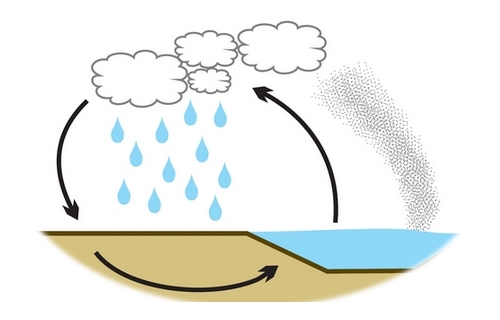The Water Cycle

Introduction
With two thirds of the earth's surface covered by water and it making up 75% of the human body (the human brain is made up of 95% water!) it is clear that water is one of the primary components of our planet. Water circulates through the land just as it does through most animals, transporting, dissolving, replenishing nutrients and organic matter, while carrying away our waste material.
Let's think about the water in this activity to understand our close and complicated relationship to it, a relationship that connects a glass of water on the kitchen table to the oceans, deserts, glaciers, hurricanes and global warming.
Activity Type
Group or Individual / Experiential and Theoretical
Duration
2 hours
Learning Outcomes
To gain an understanding of a full, natural water cycle
To understand the human influence on the water cycle
To see water as a planetary wide system
Instructions
Required Materials and Tools:
A raincoat/umbrella.
Some sticks, stones etc
A sheet of paper, coloured pens/pencils
Flipchart and flipchart pen
Step-by-Step Instructions:
Wait for it to start raining (It’s up to you how you entertain the group in this period).
Go outside and stand in the rain! It doesn’t matter if this is in a city street or the middle of the forest, although if you are with children it’s probably safer away from a road.
The group should walk around observing the flow of water, paying attention to the path the raindrop travels from appearing in the air until it vanishes. If need be, imagination should be used to follow where the drop may flow once it has vanished/merged.
Find a place where the water is flowing, how does placing the sticks and stones in its path alter the immediate course? How about further ‘downstream’?
Repeat with at least 5 different drops using different materials as blocks/obstacles.
Encourage the group to work together using all available ‘blocks’ to try and hold as much water as possible in one place.
The group should be encouraged to consider the unseen path of the raindrop, from after it disappears. What path must it take to get back into the sky to fall again here or elsewhere. How would the various ‘dams’ and ‘reservoirs’ affect this on a real-world scale?
Go back inside to the paper and drawing materials.
Individually and in as abstract a way as possible, allow the story (both seen and unseen) of all the drops to manifest itself on the pages, taking into account all the potential obstacles it can encounter on it’s way. [Allow 10 minutes]
Place all the pages next to each other, making up as large a rectangle as possible, use this layout to get a feel for the similarities and differences between the stories.
Get the group to shout out key words that come to them while looking at the mandala of pictures, write up to the first 10-15 words on the flipchart.
Resources
Reflection
How does the disrupted water cycle affect the flora and fauna?
Consider the role of soil in the water cycle.
What could be improved in our world to help regenerate full water cycles?
What was your single most-surprising discovery during this activity?
Instructions for Submission
Take a picture of the complete mandala of all the drawings and upload it in Moodle. Submit a short summary of your experience while doing the activity. Instructions on how to upload photos and how to submit things in Moodle can be found here: Instructions on Submission&Uploading
Instructions for Assessment
Provide feedback to at least one participant that has done this activity. Instructions on providing feedback can be found here: Instructions on Feedback